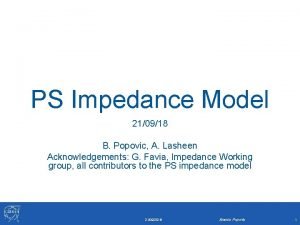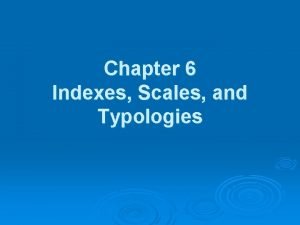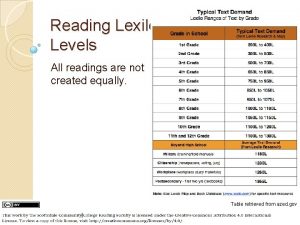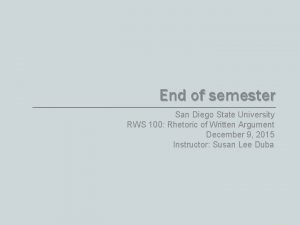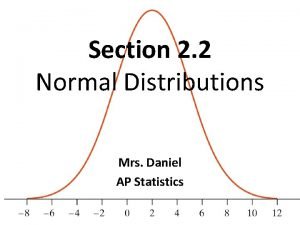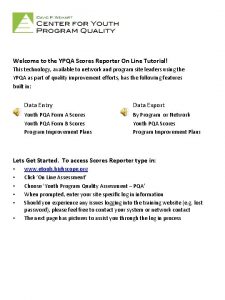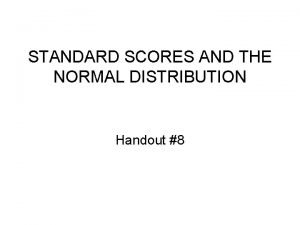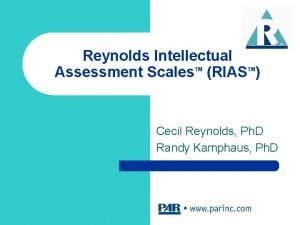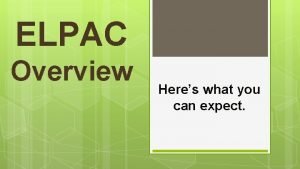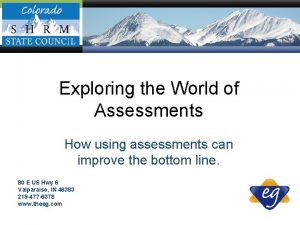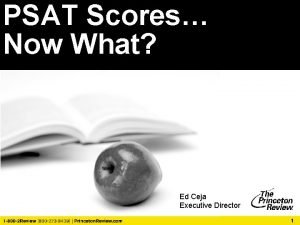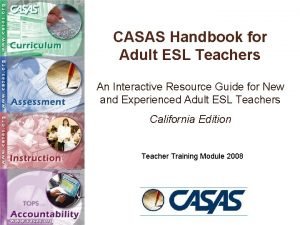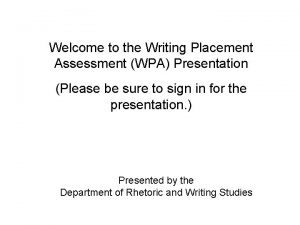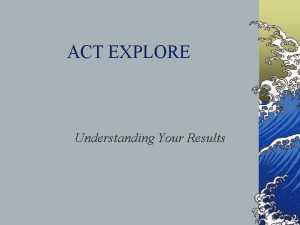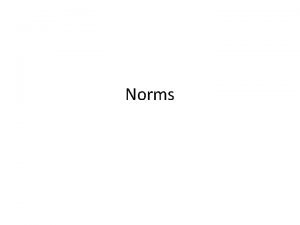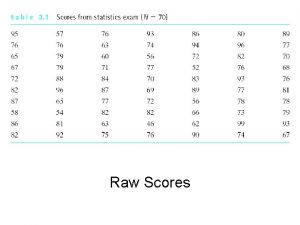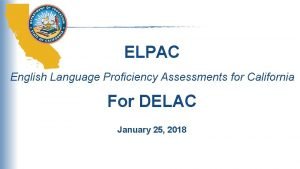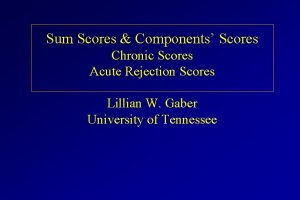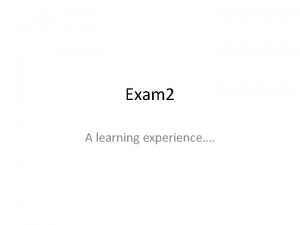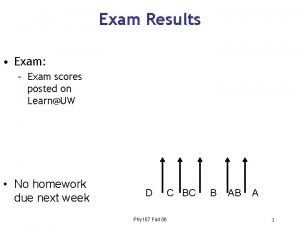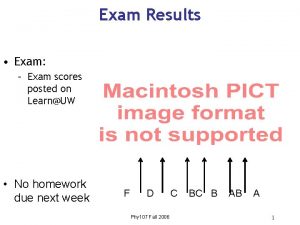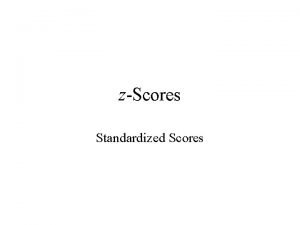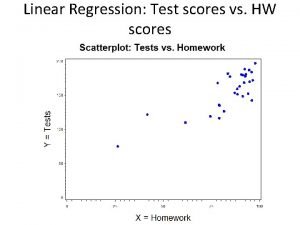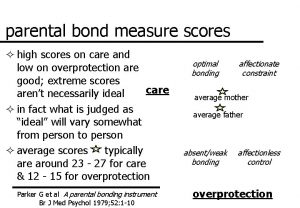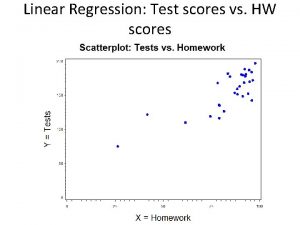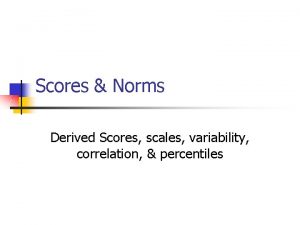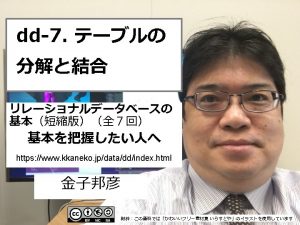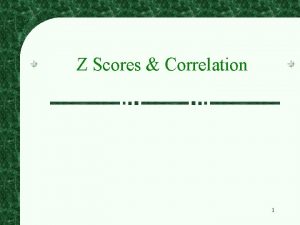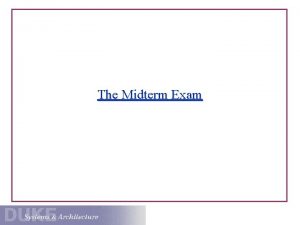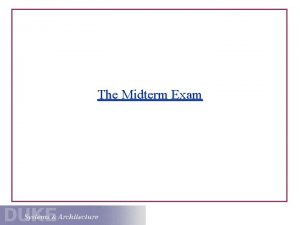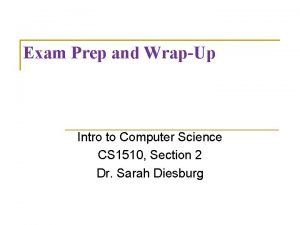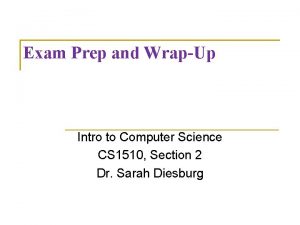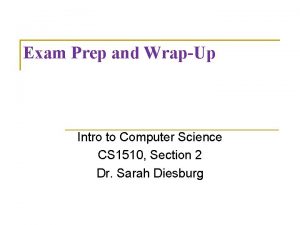Exam 1 wrapup Scores on Exam 1 10



































- Slides: 35

Exam #1 wrap-up Scores on Exam #1, 10 -15 -14 Answer key and scores are posted to Canvas. # of students 12 10 8 6 4 2 0 <70 70 -79 80 -89 90 -100 The 2 questions for which scores were the lowest: In which kind of connective tissue can you normally see a mix of cells that do and do not have nuclei? a. Connective tissue proper b. Fluid connective tissue c. Hyaline cartilage d. Supporting connective tissue Which kind of connective tissue is a major component of the walls of large arteries? a. dense irregular b. dense regular c. elastic d. smooth muscle

(Spotlight Figure 1 -1)

Chapter 6 Osseous Tissue and Bone Structure Lecture Presentation by Lee Ann Frederick University of Texas at Arlington (heavily modified by GJC) © 2015 Pearson Education, Inc.

An Introduction to the Skeletal System • The Skeletal System • What does it include? © 2015 Pearson Education, Inc.

6 -1 Functions of the Skeletal System • Five Primary Functions of the Skeletal System © 2015 Pearson Education, Inc.

Bone Shapes

Bone Shapes: Long vs. Flat Spongy bone Epiphysis Metaphysis Compact bone Diaphysis (shaft) Medullary cavity Compact bone (Cortex) Spongy bone (Diploë) Metaphysis Epiphysis Figure 6 -3 Bone Structure.

Tricky bones, example 1: wrist/hand Figure 6 -1 c

Tricky bones, example 2: parietal bone; ribs

Bone Markings – see Table 8. 1 of lab manual Projections/Processes/Elevations vs. Depressions/Openings/Tunnels 1. Projections for tendon or ligament attachment: crest, epicondyle, line, process, spine, trochanter tubercle, tuberosity 2. Projections forming joints: condyle, facet, head, ramus 3. Depressions/openings for blood vessels/nerves: fissure, foramen, groove, notch 4. Other depressions/openings: fossa, meatus, sinus Variations in bone shapes and markings offer clues about a person’s life! (next slide)

Anthropologists & pathologists analyze bones http: //anthropology. si. edu/writteninbone/ LEFT: Burned body found in fire. RIGHT: Part of baby skull, 17 thcentury Maryland.

Bone (Osseous) Tissue: semi-review Cells: Extracellular Matrix: Trabeculae of spongy bone lab manual, Figure 8. 4; textbook, Figure 6 -7

Structure of a Long Bone • Diaphysis (dye-AFF-ih-sis) • The shaft • A heavy wall of compact bone, or dense bone • A central space called medullary cavity • Epiphysis (ee-PIFF-ih-sis) • Wide part at each end • Articulation with other bones • Mostly spongy bone • Covered with compact bone (cortex) © 2015 Pearson Education, Inc.

To which forces are long bones most vulnerable?

How do bones develop and mature? • “Endochondral Ossification” • Ossifies bones that originate as hyaline cartilage • Most bones originate as hyaline cartilage • There are several steps in endochondral ossification (next slides) © 2015 Pearson Education, Inc.

Figure 6 -11 Endochondral Ossification 1 1 © 2015 Pearson Education, Inc. 2 3 4

Figure 6 -11 Endochondral Ossification (continued) 5 5 © 2015 Pearson Education, Inc. 6 7

Bone Formation and Growth • Epiphyseal Cartilage • When long bone stops growing, after puberty: • What happens to epiphyseal cartilage? • What’s visible on x-rays? © 2015 Pearson Education, Inc.

Figure 6 -10 Bone Growth at an Epiphyseal Cartilage. © 2015 Pearson Education, Inc.

End-of-chapter review question #29 Frank does not begin puberty until he is 16. What effect would you predict this will have on his stature? (a) Frank will probably be taller than if he had started puberty earlier (b) Frank will probably be shorter than if he had started puberty earlier (c) Frank will probably be a dwarf (d) Frank will have bones that are heavier than normal (e) The late onset of puberty will have no effect on Frank’s stature © 2015 Pearson Education, Inc.

Bone Remodeling • Process of Remodeling • The adult skeleton: • Replaces mineral reserves • Recycles and renews bone matrix • Involves 3 cell types: © 2015 Pearson Education, Inc.

Bone Remodeling Shin & Cho, Journal of Korean Society of Endocrinology 2005

Bone Remodeling • Process of Remodeling • Bone continually remodels, recycles, and replaces • What happens if deposition is greater than removal? • What happens if removal is faster than replacement? © 2015 Pearson Education, Inc.

Bone remodeling & exercise: “Use it or lose it!” • Bed rest or “couch potato” behavior • Exercise (are all forms equally good? ) J. F. Nichols et al. , Osteoporosis International 2003

What would you recommend to maintain optimal bone density?

Bones, Hormones, and Nutrition • Normal Bone Growth and Maintenance Depend on Nutritional and Hormonal Factors • The hormone calcitriol • Made where? • Helps digestive tract absorb what? • Synthesis requires what precursor? © 2015 Pearson Education, Inc.

Bones & Hormones • Osteoblast activity and synthesis of bone matrix is stimulated by hormones like growth hormone and estrogens/androgens. • Implications for anorexic teenagers? • Implications for older folks?

6 -8 Calcium Homeostasis • The Skeleton as a Calcium Reserve • Bones store calcium and other minerals • Calcium ions are vital to: • Neurons • Muscle cells, especially heart cells © 2015 Pearson Education, Inc.

Calcium Homeostasis • Calcium ions in body fluids must be closely regulated • Homeostasis is maintained by 2 hormones: © 2015 Pearson Education, Inc.

Figure 6 -15 a Factors That Alter the Concentration of Calcium Ions in Blood. a Factors That Increase Blood Calcium Levels Low Calcium Ion Levels in Blood (below 8. 5 mg/d. L) Parathyroid Gland Response Low calcium levels cause the parathyroid glands to secrete parathyroid hormone (PTH). PTH Bone Response Osteoclasts stimulated to release stored calcium ions from bone Intestinal Response Rate of intestinal absorption of calcium increases Kidney Response Kidneys retain calcium ions more calcitriol Calcium released Calcium absorbed quickly Ca 2+ levels in blood increase © 2015 Pearson Education, Inc. Calcium conserved Decreased calcium loss in urine

Figure 6 -15 b Factors That Alter the Concentration of Calcium Ions in Blood. b Factors That Decrease Blood Calcium Levels High Calcium Ion Levels in Blood (above 11 mg/d. L) Thyroid Gland Response Parafollicular cells (C cells) in the thyroid gland secrete calcitonin. Calcitonin Bone Response Intestinal Response Osteoclasts inhibited while Rate of osteoblasts continue to lock intestinal calcium ions in bone matrix absorption of calcium decreases Calcium stored Kidneys allow calcium loss less calcitriol Calcium absorbed slowly Calcium excreted Ca 2+ levels in blood decrease © 2015 Pearson Education, Inc. Kidney Response Increased calcium loss in urine

Figure 6 -15 set to music When blood calcium is high, The thyroid sends out calcitonin. When blood calcium is low, The parathyroid gland gets goin’. Melody playback: http: //www. noteflight. com/scores/view/0 cbd 7455 cee 28 fb 56162 b 76 aef 5256602 dd 2 c 6 ee

Summary of homeostasis in preceding figure • Regulated variable? • Setpoint? • Effectors? © 2015 Pearson Education, Inc.

Fractures • Cracks or breaks in bones • Caused by physical stress • Fractures are repaired in four steps 1. Bleeding 2. Cells of the endosteum and periosteum 3. Osteoblasts 4. Osteoblasts and osteocytes remodel the fracture for up to a year © 2015 Pearson Education, Inc.

Figure 6 -16 Types of Fractures and Steps in Repair. Spongy bone of internal callus Cartilage of external callus Fracture hematoma External callus Dead bone 1 Bone fragments Fracture hematoma formation. Spongy bone of external callus 2 Periosteum Callus formation. Internal callus 3 External callus Spongy bone formation. Compare & contrast with inflammation! Inflammation “First responder” cells Initial response Later rebuilding “Good as new”? © 2015 Pearson Education, Inc. Bone Fracture 4 Compact bone formation.
 @t.kfa:wrapup.playstation.com
@t.kfa:wrapup.playstation.com Indexes scales and typologies
Indexes scales and typologies Ic&rc exam scores
Ic&rc exam scores Ace scores
Ace scores Gnu robots
Gnu robots Lexile levels
Lexile levels Rws sdsu
Rws sdsu Math inventory score chart 2020
Math inventory score chart 2020 Mrs daniel ap stats
Mrs daniel ap stats Ypqa
Ypqa Standardized normal distribution formula
Standardized normal distribution formula Reynolds intellectual assessment scales
Reynolds intellectual assessment scales What is a good act aspire score
What is a good act aspire score Jmu cluster classes
Jmu cluster classes Interpreting psat scores
Interpreting psat scores Ielts presentation
Ielts presentation Dlpt scoring
Dlpt scoring How to pass the elpac test
How to pass the elpac test Act score range
Act score range What is attainment 8
What is attainment 8 Desmos mississippi
Desmos mississippi Hexagon agility test normal score
Hexagon agility test normal score Sten scores and percentiles
Sten scores and percentiles Georgia milestones score range
Georgia milestones score range Psat score chart
Psat score chart Vertical scaled score
Vertical scaled score For adult
For adult Kaufman test of educational achievement scores
Kaufman test of educational achievement scores Sdsu wpa score
Sdsu wpa score Alabama high school volleyball rules
Alabama high school volleyball rules Jane horney
Jane horney Act explore
Act explore Interpreting test scores and norms
Interpreting test scores and norms Grouped frequency table
Grouped frequency table What are the elpac levels
What are the elpac levels Key stage 1 scaled scores
Key stage 1 scaled scores
